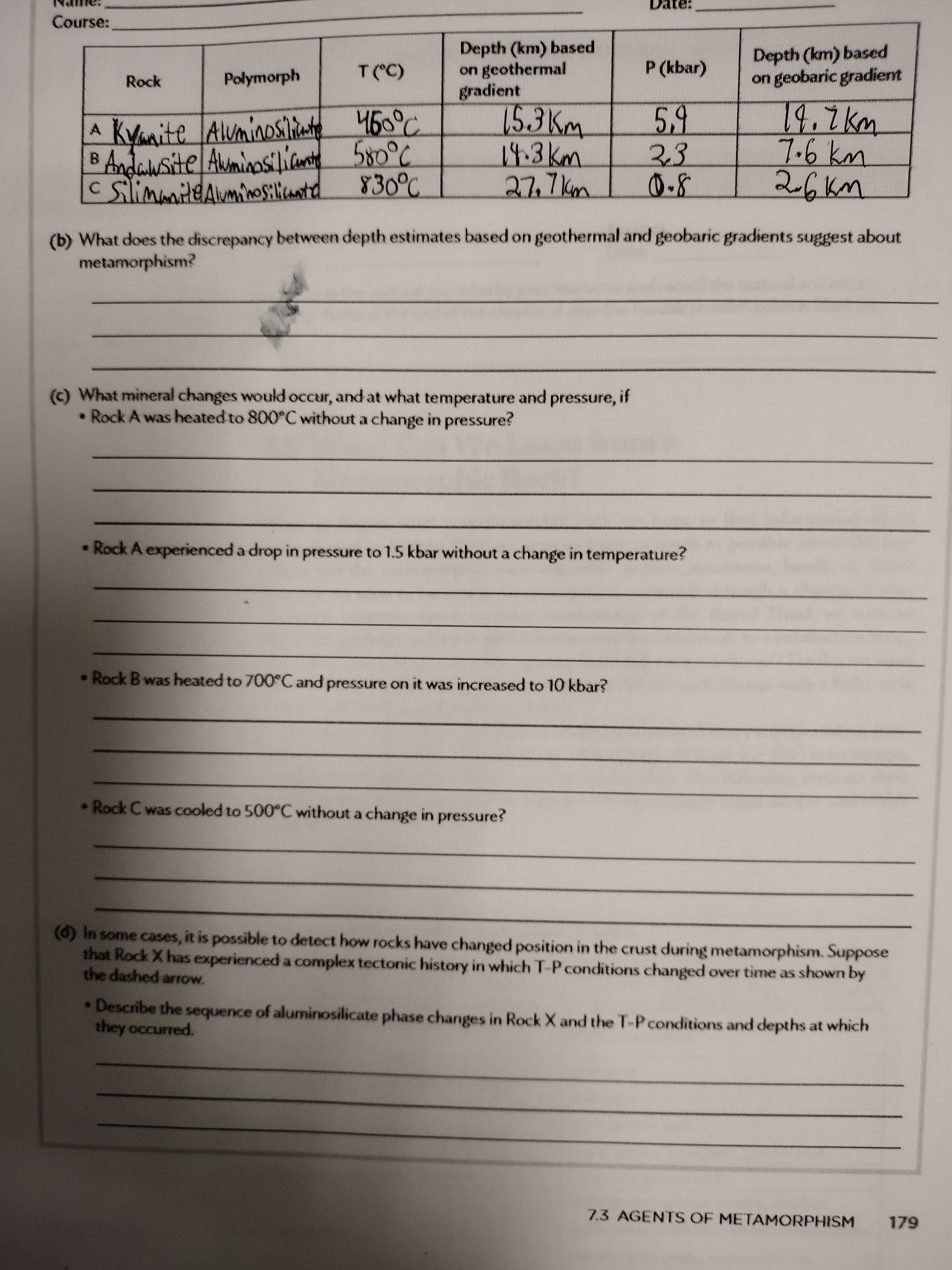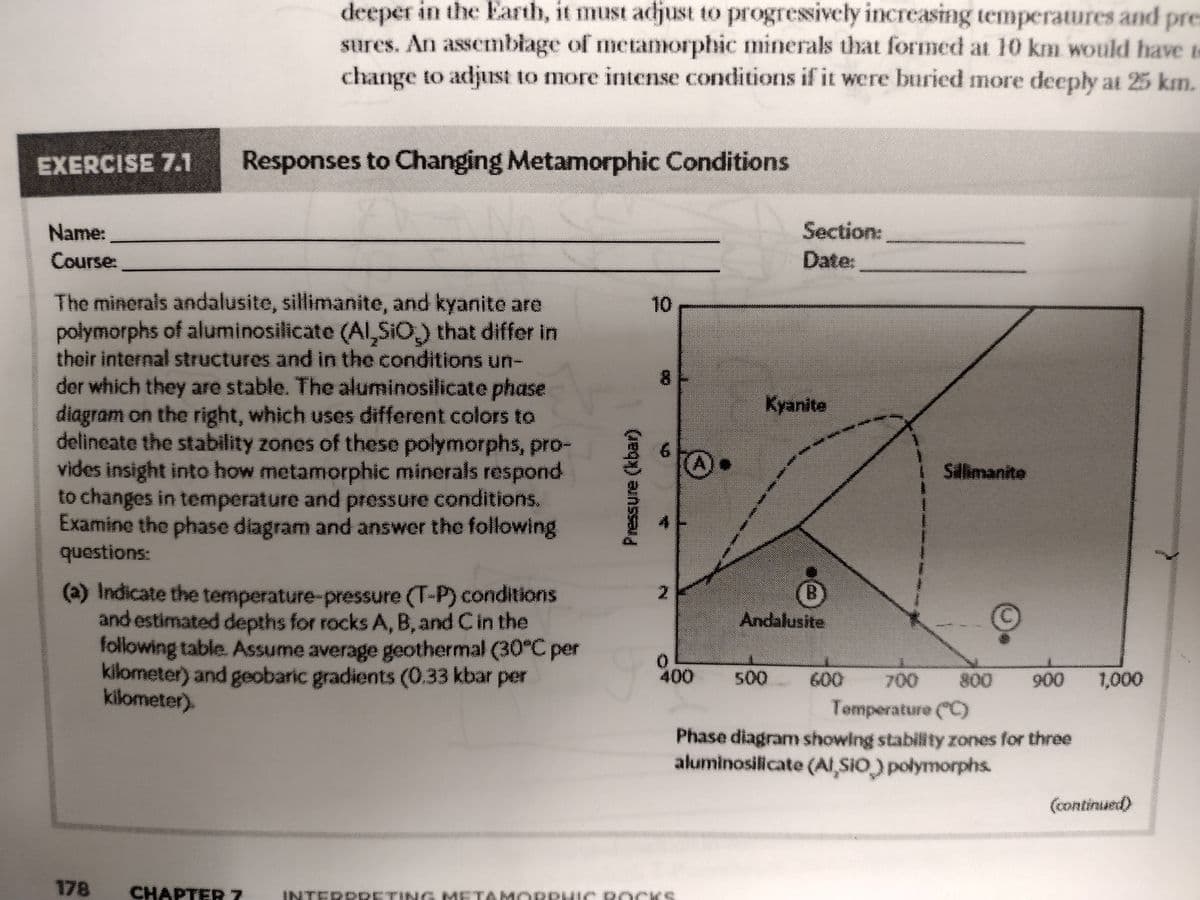Course: Depth (km) based on geothermal gradient Depth (km) based on geobaric gradient P (kbar) Rock Polymorph A Kyanite Aluminosiat 450°C Andawsite Awminasiiante 580°C 830°C. 14:3km 27,7km 33 B. 66km (b) What does the discrepancy between depth estimates based on geothermal and geobaric gradients suggest about metamorphism? (c) What mineral changes would occur, and at what temperature and pressure, if • Rock A was heated to 800°C without a change in pressure? • Rock A experienced a drop in pressure to 1.5 kbar without a change in temperature? • Rock B was heated to 700°C and pressure on it was increased to 10 kbar? Rock C was cooled to 500°C without a change in pressure? (d) In some cases, it is possible to detect how rocks have changed position in the crust during metamorphism. Suppose that Rock X has experienced a complex tectonic history in which T-P conditions changed over time as shown by the dashed arow. • Describe the sequence of aluminosilicate phase changes in Rock X and the T-P conditions and depths at which they occurred. 7.3 AGENTS OF METAMORPHISM deeper in the Earth, it must adjust to progressively increasing temperatures and pre sures. An assembiage of metamorphic minerals that formed at 10 km would have to change to adjust to more intense conditions if it were buried more deeply at 25 km. EXERCISE 7.1 Responses to Changing Metamorphic Conditions Name: Section: Course: Date: The minerals andalusite, sillimanite, and kyanite are polymorphs of aluminosilicate (AI, SIO) that differ in their internal structures and in the conditions un- der which they are stable. The aluminosilicate phase diagram on the right, which uses different colors to delineate the stability zones of these polymorphs, pro- vides insight into how metamorphic minerals respond to changes in temperature and pressure conditions. Examine the phase diagram and answer the following questions: 10 Kyanite (A Salimanite (a) Indicate the temperature-pressure (T-P) conditions and estimated depths for rocks A, B, and Cin the following table. Assume average geothermal (30°C per kilometer) and geobaric gradients (0.33 kbar per kilometer). Andalusite 400 500 600 700 800 900 1,000 Temperature (C) Phase diagram showing stability zones for three aluminosilicate (AI SIO) polymorphs. (continued) 178 CHAPTER 7 INTERD DETING METAM ORPHIC POCKe Pressure (kbar)
Course: Depth (km) based on geothermal gradient Depth (km) based on geobaric gradient P (kbar) Rock Polymorph A Kyanite Aluminosiat 450°C Andawsite Awminasiiante 580°C 830°C. 14:3km 27,7km 33 B. 66km (b) What does the discrepancy between depth estimates based on geothermal and geobaric gradients suggest about metamorphism? (c) What mineral changes would occur, and at what temperature and pressure, if • Rock A was heated to 800°C without a change in pressure? • Rock A experienced a drop in pressure to 1.5 kbar without a change in temperature? • Rock B was heated to 700°C and pressure on it was increased to 10 kbar? Rock C was cooled to 500°C without a change in pressure? (d) In some cases, it is possible to detect how rocks have changed position in the crust during metamorphism. Suppose that Rock X has experienced a complex tectonic history in which T-P conditions changed over time as shown by the dashed arow. • Describe the sequence of aluminosilicate phase changes in Rock X and the T-P conditions and depths at which they occurred. 7.3 AGENTS OF METAMORPHISM deeper in the Earth, it must adjust to progressively increasing temperatures and pre sures. An assembiage of metamorphic minerals that formed at 10 km would have to change to adjust to more intense conditions if it were buried more deeply at 25 km. EXERCISE 7.1 Responses to Changing Metamorphic Conditions Name: Section: Course: Date: The minerals andalusite, sillimanite, and kyanite are polymorphs of aluminosilicate (AI, SIO) that differ in their internal structures and in the conditions un- der which they are stable. The aluminosilicate phase diagram on the right, which uses different colors to delineate the stability zones of these polymorphs, pro- vides insight into how metamorphic minerals respond to changes in temperature and pressure conditions. Examine the phase diagram and answer the following questions: 10 Kyanite (A Salimanite (a) Indicate the temperature-pressure (T-P) conditions and estimated depths for rocks A, B, and Cin the following table. Assume average geothermal (30°C per kilometer) and geobaric gradients (0.33 kbar per kilometer). Andalusite 400 500 600 700 800 900 1,000 Temperature (C) Phase diagram showing stability zones for three aluminosilicate (AI SIO) polymorphs. (continued) 178 CHAPTER 7 INTERD DETING METAM ORPHIC POCKe Pressure (kbar)
An Introduction to Physical Science
14th Edition
ISBN:9781305079137
Author:James Shipman, Jerry D. Wilson, Charles A. Higgins, Omar Torres
Publisher:James Shipman, Jerry D. Wilson, Charles A. Higgins, Omar Torres
Chapter22: Minerals, Rocks, And Volcanoes
Section: Chapter Questions
Problem LM
Related questions
Topic Video
Question
I just need parts b and c answered and use the graph when its asking for what changes would occur.

Transcribed Image Text:Course:
Depth (km) based
on geothermal
gradient
Depth (km) based
on geobaric gradient
P (kbar)
Rock
Polymorph
A Kyanite Aluminosiat
450°C
Andawsite Awminasiiante 580°C
830°C.
14:3km
27,7km
33
B.
66km
(b) What does the discrepancy between depth estimates based on geothermal and geobaric gradients suggest about
metamorphism?
(c) What mineral changes would occur, and at what temperature and pressure, if
• Rock A was heated to 800°C without a change in pressure?
• Rock A experienced a drop in pressure to 1.5 kbar without a change in temperature?
• Rock B was heated to 700°C and pressure on it was increased to 10 kbar?
Rock C was cooled to 500°C without a change in pressure?
(d) In some cases, it is possible to detect how rocks have changed position in the crust during metamorphism. Suppose
that Rock X has experienced a complex tectonic history in which T-P conditions changed over time as shown by
the dashed arow.
• Describe the sequence of aluminosilicate phase changes in Rock X and the T-P conditions and depths at which
they occurred.
7.3 AGENTS OF METAMORPHISM

Transcribed Image Text:deeper in the Earth, it must adjust to progressively increasing temperatures and pre
sures. An assembiage of metamorphic minerals that formed at 10 km would have to
change to adjust to more intense conditions if it were buried more deeply at 25 km.
EXERCISE 7.1
Responses to Changing Metamorphic Conditions
Name:
Section:
Course:
Date:
The minerals andalusite, sillimanite, and kyanite are
polymorphs of aluminosilicate (AI, SIO) that differ in
their internal structures and in the conditions un-
der which they are stable. The aluminosilicate phase
diagram on the right, which uses different colors to
delineate the stability zones of these polymorphs, pro-
vides insight into how metamorphic minerals respond
to changes in temperature and pressure conditions.
Examine the phase diagram and answer the following
questions:
10
Kyanite
(A
Salimanite
(a) Indicate the temperature-pressure (T-P) conditions
and estimated depths for rocks A, B, and Cin the
following table. Assume average geothermal (30°C per
kilometer) and geobaric gradients (0.33 kbar per
kilometer).
Andalusite
400
500
600
700
800
900
1,000
Temperature (C)
Phase diagram showing stability zones for three
aluminosilicate (AI SIO) polymorphs.
(continued)
178
CHAPTER 7
INTERD DETING METAM ORPHIC POCKe
Pressure (kbar)
Expert Solution
This question has been solved!
Explore an expertly crafted, step-by-step solution for a thorough understanding of key concepts.
This is a popular solution!
Trending now
This is a popular solution!
Step by step
Solved in 2 steps

Knowledge Booster
Learn more about
Need a deep-dive on the concept behind this application? Look no further. Learn more about this topic, physics and related others by exploring similar questions and additional content below.Recommended textbooks for you

An Introduction to Physical Science
Physics
ISBN:
9781305079137
Author:
James Shipman, Jerry D. Wilson, Charles A. Higgins, Omar Torres
Publisher:
Cengage Learning

An Introduction to Physical Science
Physics
ISBN:
9781305079137
Author:
James Shipman, Jerry D. Wilson, Charles A. Higgins, Omar Torres
Publisher:
Cengage Learning